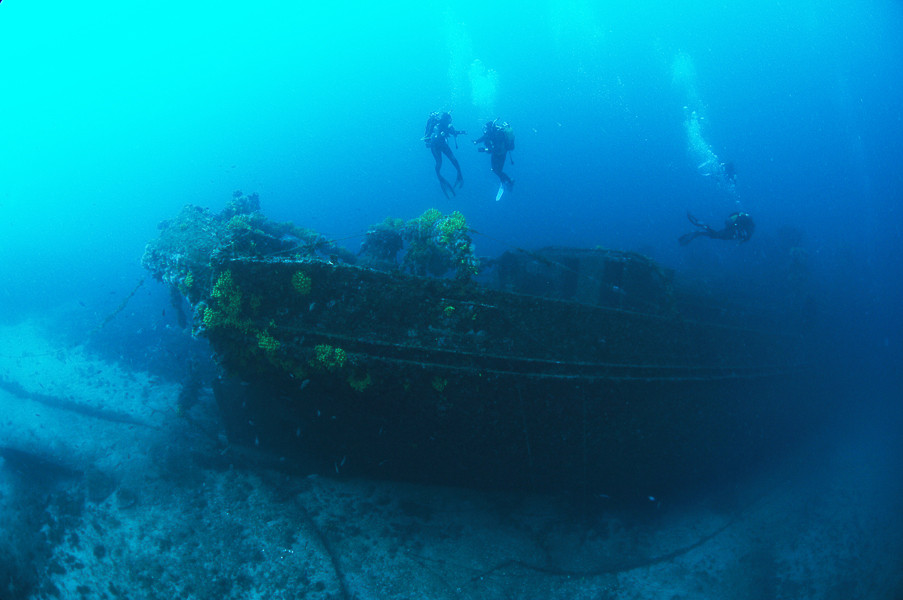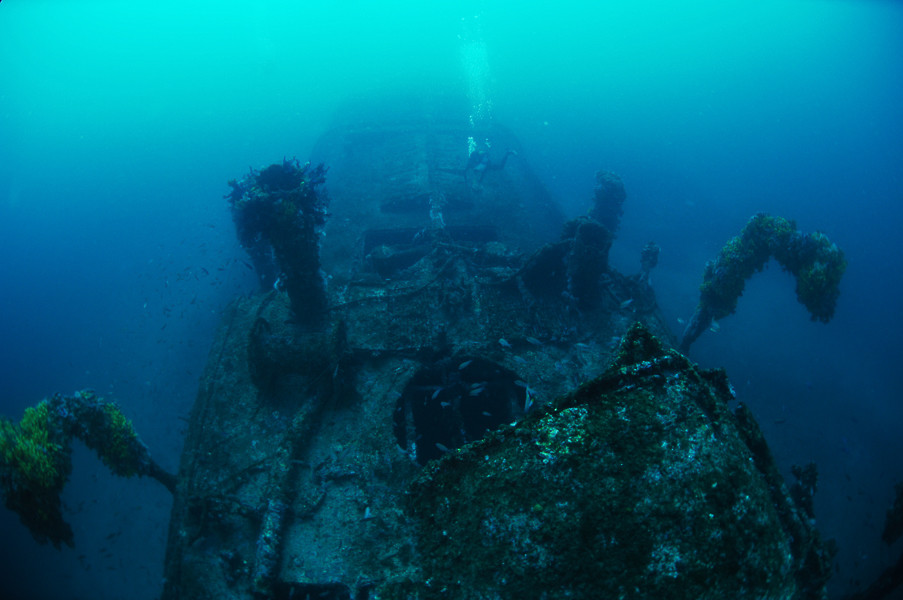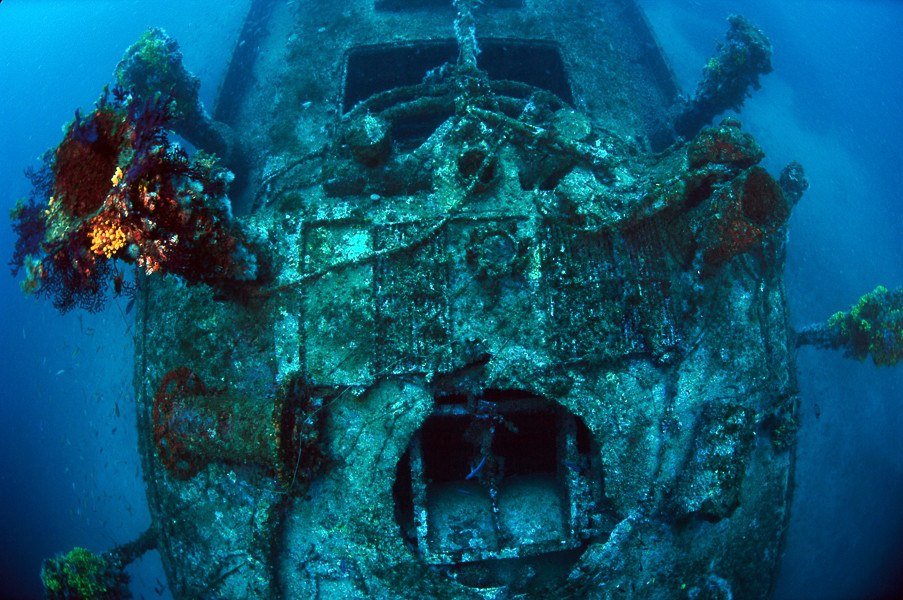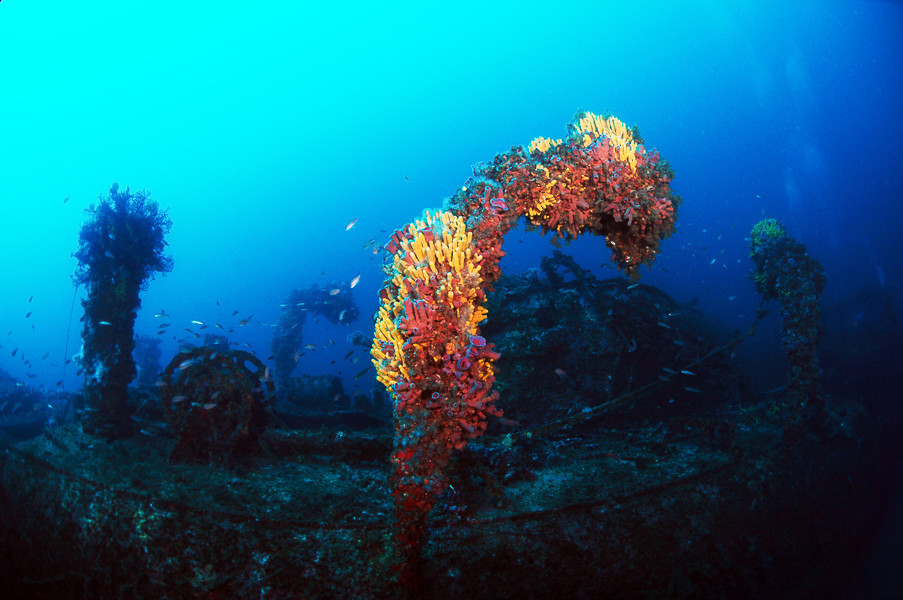
URSUS
DEPTH: 45 - 60 m
SKILL: Expert
Ursus (F.94); tugboat; Italian
Built: 1918, Venice
Sunk: 13th January 1941 (sunk by British submarine the Rorqual)
Dimensions: l=about 36 m, w=about 5 m, h=about 3 m, 407 GRT
Coordinates: 43.06977° N 16.26230° E
Location: About 400 m from the Cape of Stončica, island of Vis.
Access: 1/5 access is possible only by boat
Visibility: 4/5 mostly very good
Current: 3/5 moderate
Flora and fauna: 5/5 varied life on and around the wreck, occasionally specimens of large fish
HISTORY:
The naval battle between the British submarine Rorqual and two Italian ships in the waters between the islands of Korčula, Sušac and Vis took place just two months before the outbreak of the war and attack on Yugoslavia.
On 30th January 1940 the tugboat Ursus, which had towed out the armed pontoon GM 239 (Regio Pontone Armato), sailed out from Zadar an Italian enclave on the Eastern Adriatic. Armed pontoons were in fact floating structures without their own engines on which were placed large calibre guns. Before the war the Ursus belonged to the company Soc. An. Rimorchiatori Riuniti Panfido from Venice. During the war the Italian Navy mobilized it and armed it with one small 76 mm gun.
On the morning of 31st December the ships passed along the north-eastern coast of Vis, and then they proceeded towards Korčula and Lastovo. On the open sea between Vis, Korčula and Sušac about noon a submarine suddenly surfaced about 1-2 miles away. It was the British submarine-minelayer the Rorqual, a veteran of war in the Adriatic. Immediately after surfacing, the submarine began firing its guns at the Italian ships. The first shells fell on the Ursus, one of which hit the engine room. The boat caught fire, which swept through the cargo on the deck which consisted of shells for the pontoon. Several explosions happened, which threw some members of the crew into the sea. The damaged boat began to sink. The crew managed to lower one of the boat’s dinghies, in which they laid the wounded. In the meantime the crew of the pontoon cut the towing rope and began firing at the submarine. After a brief battle a seaplane of the Royal Yugoslav Navy appeared. The submarine abruptly ceased firing and submerged. The crew of the pontoon began pulling survivors from the Ursus and so saving the commander and six sailors. Two bodies of those killed were also pulled from the sea. The weather worsened, and the wind and waves were carrying the helpless pontoon towards the island of Hvar. A tug from Lastovo which was called in the meantime to help, disappeared in the darkness. During the night a great storm gained strength in which the terribly ruined pontoon threatened to turnover at any moment. Part of the crew (15 people) in a panic left the boat in two lifeboats. At dawn the pontoon driven by the waves and wind floated to the island of Hvar where the crew managed to anchor it in one cove. With the help of signalling flares they tried to summon help. Sailing nearby at the moment was the steamship Drava which noticed the light of the signals, and then took the pontoon in tow and towed it to the port of Hvar.
Only after the pontoon was moored in Hvar did the dimensions of this maritime tragedy began to become clear. In the bad weather the crew (8 people) of one dinghy had died whose bodies and shattered dinghy were found along the shore of Hvar. Two more had drowned and they were found close to the Pokonji Dol lighthouse, and the other dinghy from the pontoon was not found. The dinghy from the Ursus with four exhausted men, and one dead, were found by fishermen from Vela Luka at the last moment before the incoming storm. Thus the first naval battle of the Second World War in the waters of the Eastern Adriatic ended with the noble act of the rescuing of survivors, which somewhat eased its tragic consequences.
WRECK CONDITION AND DIVING:
The wreck of the Ursus was completely unknown to the diving world until recently. That, as well as the fact that its position is deep and far away from the coast of Vis, is the reason that the boat is completely intact. The position of the Ursus is located near the cape of Stončica, about 400 m away from the coast. The boat sank along one underwater mound, the peak of which is at about a depth of 35 metres, and which slopes gently towards the northwest. When the boat sank, it slipped down a sandy slope, with its bow towards the depths. It still lies in this position even today. The dive starts from the top of the underwater hill, from which it takes a direction towards the northwest. At a depth of 40 metres swimming more towards the west we come across the steel cable, which will lead us directly to the stern of the Ursus. This is the towing cable which the crew of the pontoon cut at the beginning of the battle in an attempt to separate themselves from the Ursus. From the deep the semi-circular stern of the Ursus quickly emerges which is at a depth of 45 metres. At the end of the stern can be clearly seen the nameplate with the letters of its name and home port (Venice) which were riveted to the steel substrate. At end of the stern is one circular opening which leads below decks from which a large conger eels peeks. Through the portholes one can peek into the engine room, where the steam engine looms.
Of the bridge, as usual, there is not much left since it was wooden, and in the battle it caught fire. The forward deck is significantly deep – the echo sounder indicates almost 55 metres. The forward deck is dominated by a 76 mm calibre gun turned to starboard, aimed today as it was then towards the invisible submarine. Both vertical sides of the bow are richly overgrown with red sea fans, which due to the undersea currents here have plenty of food. The bow’s lower section is embedded in the sand, as though it was sailing, at a depth of 60 metres. The anchors are in situ and are also overgrown with sea fans. At the bow’s railing large groupers linger around. This little boat is not difficult to go around in a single dive. For the return it is necessary to select a reverse path, so the steel cable will take us from the stern to the underwater mound from where we began.
For this dive one should select the appropriate equipment and plan every phase of the dive, because it is a technical dive which mostly exceeds the limits of sports diving of 40 metres. However precisely due to its history, the extraordinary condition of preservation and rich underwater life, the Ursus is must destination for every serious lover of wrecks.
Note: The Ursus lies within the zone of the island of Vis where one cannot dive without permission. Diving should be arranged with an authorised diving centre, of which there are several on Vis.
The description and illustrations are a courtesy of Danijel Frka and Jasen Mesić. Buy the whole book here: https://shop.naklada-val.hr/product_info.php?products_id=561
Built: 1918, Venice
Sunk: 13th January 1941 (sunk by British submarine the Rorqual)
Dimensions: l=about 36 m, w=about 5 m, h=about 3 m, 407 GRT
Coordinates: 43.06977° N 16.26230° E
Location: About 400 m from the Cape of Stončica, island of Vis.
Access: 1/5 access is possible only by boat
Visibility: 4/5 mostly very good
Current: 3/5 moderate
Flora and fauna: 5/5 varied life on and around the wreck, occasionally specimens of large fish
HISTORY:
The naval battle between the British submarine Rorqual and two Italian ships in the waters between the islands of Korčula, Sušac and Vis took place just two months before the outbreak of the war and attack on Yugoslavia.
On 30th January 1940 the tugboat Ursus, which had towed out the armed pontoon GM 239 (Regio Pontone Armato), sailed out from Zadar an Italian enclave on the Eastern Adriatic. Armed pontoons were in fact floating structures without their own engines on which were placed large calibre guns. Before the war the Ursus belonged to the company Soc. An. Rimorchiatori Riuniti Panfido from Venice. During the war the Italian Navy mobilized it and armed it with one small 76 mm gun.
On the morning of 31st December the ships passed along the north-eastern coast of Vis, and then they proceeded towards Korčula and Lastovo. On the open sea between Vis, Korčula and Sušac about noon a submarine suddenly surfaced about 1-2 miles away. It was the British submarine-minelayer the Rorqual, a veteran of war in the Adriatic. Immediately after surfacing, the submarine began firing its guns at the Italian ships. The first shells fell on the Ursus, one of which hit the engine room. The boat caught fire, which swept through the cargo on the deck which consisted of shells for the pontoon. Several explosions happened, which threw some members of the crew into the sea. The damaged boat began to sink. The crew managed to lower one of the boat’s dinghies, in which they laid the wounded. In the meantime the crew of the pontoon cut the towing rope and began firing at the submarine. After a brief battle a seaplane of the Royal Yugoslav Navy appeared. The submarine abruptly ceased firing and submerged. The crew of the pontoon began pulling survivors from the Ursus and so saving the commander and six sailors. Two bodies of those killed were also pulled from the sea. The weather worsened, and the wind and waves were carrying the helpless pontoon towards the island of Hvar. A tug from Lastovo which was called in the meantime to help, disappeared in the darkness. During the night a great storm gained strength in which the terribly ruined pontoon threatened to turnover at any moment. Part of the crew (15 people) in a panic left the boat in two lifeboats. At dawn the pontoon driven by the waves and wind floated to the island of Hvar where the crew managed to anchor it in one cove. With the help of signalling flares they tried to summon help. Sailing nearby at the moment was the steamship Drava which noticed the light of the signals, and then took the pontoon in tow and towed it to the port of Hvar.
Only after the pontoon was moored in Hvar did the dimensions of this maritime tragedy began to become clear. In the bad weather the crew (8 people) of one dinghy had died whose bodies and shattered dinghy were found along the shore of Hvar. Two more had drowned and they were found close to the Pokonji Dol lighthouse, and the other dinghy from the pontoon was not found. The dinghy from the Ursus with four exhausted men, and one dead, were found by fishermen from Vela Luka at the last moment before the incoming storm. Thus the first naval battle of the Second World War in the waters of the Eastern Adriatic ended with the noble act of the rescuing of survivors, which somewhat eased its tragic consequences.
WRECK CONDITION AND DIVING:
The wreck of the Ursus was completely unknown to the diving world until recently. That, as well as the fact that its position is deep and far away from the coast of Vis, is the reason that the boat is completely intact. The position of the Ursus is located near the cape of Stončica, about 400 m away from the coast. The boat sank along one underwater mound, the peak of which is at about a depth of 35 metres, and which slopes gently towards the northwest. When the boat sank, it slipped down a sandy slope, with its bow towards the depths. It still lies in this position even today. The dive starts from the top of the underwater hill, from which it takes a direction towards the northwest. At a depth of 40 metres swimming more towards the west we come across the steel cable, which will lead us directly to the stern of the Ursus. This is the towing cable which the crew of the pontoon cut at the beginning of the battle in an attempt to separate themselves from the Ursus. From the deep the semi-circular stern of the Ursus quickly emerges which is at a depth of 45 metres. At the end of the stern can be clearly seen the nameplate with the letters of its name and home port (Venice) which were riveted to the steel substrate. At end of the stern is one circular opening which leads below decks from which a large conger eels peeks. Through the portholes one can peek into the engine room, where the steam engine looms.
Of the bridge, as usual, there is not much left since it was wooden, and in the battle it caught fire. The forward deck is significantly deep – the echo sounder indicates almost 55 metres. The forward deck is dominated by a 76 mm calibre gun turned to starboard, aimed today as it was then towards the invisible submarine. Both vertical sides of the bow are richly overgrown with red sea fans, which due to the undersea currents here have plenty of food. The bow’s lower section is embedded in the sand, as though it was sailing, at a depth of 60 metres. The anchors are in situ and are also overgrown with sea fans. At the bow’s railing large groupers linger around. This little boat is not difficult to go around in a single dive. For the return it is necessary to select a reverse path, so the steel cable will take us from the stern to the underwater mound from where we began.
For this dive one should select the appropriate equipment and plan every phase of the dive, because it is a technical dive which mostly exceeds the limits of sports diving of 40 metres. However precisely due to its history, the extraordinary condition of preservation and rich underwater life, the Ursus is must destination for every serious lover of wrecks.
Note: The Ursus lies within the zone of the island of Vis where one cannot dive without permission. Diving should be arranged with an authorised diving centre, of which there are several on Vis.
The description and illustrations are a courtesy of Danijel Frka and Jasen Mesić. Buy the whole book here: https://shop.naklada-val.hr/product_info.php?products_id=561








 The investment is co-financed by the Republic of Slovenia and the European Union from the European Regional Development Fund.
The investment is co-financed by the Republic of Slovenia and the European Union from the European Regional Development Fund.  H2O Globe BETA
H2O Globe BETA